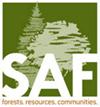Predictors of Landowners’ Intention to Manage Emerald Ash Borer in Kentucky
IF 1.5
4区 农林科学
Q2 FORESTRY
引用次数: 0
Abstract
Native ash species in the central hardwood region of the United States have been threatened by infestations of emerald ash borers (EAB), which have caused significant damage to the forests’ ecological and economic value. Because private landowners own most of these forestlands, their knowledge, attitudes, and behavior are important in managing EAB effectively across the landscape. We conducted a mail survey of landowners in Kentucky, where EAB are spreading across the state and causing variable levels of damage depending upon how long they have been established, and assessed whether and how psychosocial and demographic factors help explain the landowner’s behavioral intention to manage EAB on their property. The results of an ordinal logistic regression model, grounded in a modified theory of planned behavior framework, suggested that severity of risk perception, knowledge about management options, importance of economic objectives, and perceived group efficacy were related positively to landowners’ intention to manage EAB. These findings shed light on landowners’ perspective of EAB’s effects and the role of psychosocial factors in their motivation to adopt EAB control options. Study Implications: Landowners’ active participation can be critical in managing EAB effectively in privately owned forests. This study found that landowners’ management intentions depended on their perception of EAB risks, knowledge of EAB prevention, and perceived cooperation among landowners. Raising awareness of EAB threats, educating landowners on the control options available, and promoting collaborative approaches to combat EAB at the regional scale can help increase landowners’ participation in EAB management. Taking a collaborative approach is important to address such transboundary problems as EAB infestations because such an approach ensures that relevant agencies will provide landowners with continuous legal, technical, and financial support.肯塔基州土地所有者管理祖母绿灰螟意愿的预测因素
美国中部阔叶林地区的原生白蜡树种受到了绿灰蛀虫(EAB)的威胁,对森林的生态和经济价值造成了严重的破坏。由于私人土地所有者拥有这些林地的大部分,他们的知识、态度和行为对于有效地管理整个景观中的EAB非常重要。我们对肯塔基州的土地所有者进行了一项邮件调查,在肯塔基州,EAB正在全州蔓延,并根据其建立的时间长短造成不同程度的损害,并评估了社会心理和人口统计学因素是否以及如何帮助解释了土地所有者在其财产上管理EAB的行为意图。基于改进的计划行为框架理论的有序逻辑回归模型的结果表明,风险感知的严重程度、管理选择的知识、经济目标的重要性和感知的群体效能与土地所有者管理EAB的意愿呈正相关。这些发现揭示了土地所有者对EAB影响的看法,以及社会心理因素在他们采取EAB控制方案的动机中的作用。研究意义:土地所有者的积极参与对于有效管理私人拥有的森林中的EAB至关重要。本研究发现,土地所有者的管理意愿取决于其对EAB风险的认知、对EAB预防知识的认知以及对土地所有者之间合作的认知。提高对虫害威胁的认识,教育土地所有者了解现有的控制选择,并促进在区域范围内采取合作方法来打击虫害,有助于提高土地所有者对虫害管理的参与。采取合作方法对于解决诸如EAB侵扰等跨界问题很重要,因为这种方法确保有关机构将向土地所有者提供持续的法律、技术和财政支持。
本文章由计算机程序翻译,如有差异,请以英文原文为准。
求助全文
约1分钟内获得全文
求助全文
来源期刊

Forest Science
农林科学-林学
CiteScore
2.80
自引率
7.10%
发文量
45
审稿时长
3 months
期刊介绍:
Forest Science is a peer-reviewed journal publishing fundamental and applied research that explores all aspects of natural and social sciences as they apply to the function and management of the forested ecosystems of the world. Topics include silviculture, forest management, biometrics, economics, entomology & pathology, fire & fuels management, forest ecology, genetics & tree improvement, geospatial technologies, harvesting & utilization, landscape ecology, operations research, forest policy, physiology, recreation, social sciences, soils & hydrology, and wildlife management.
Forest Science is published bimonthly in February, April, June, August, October, and December.
 求助内容:
求助内容: 应助结果提醒方式:
应助结果提醒方式:


